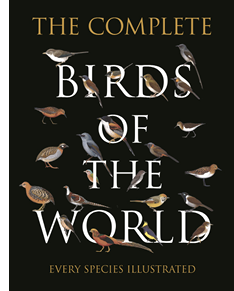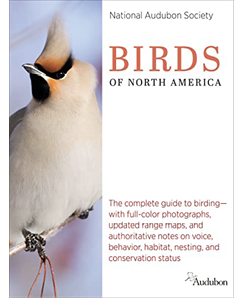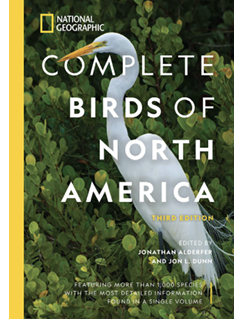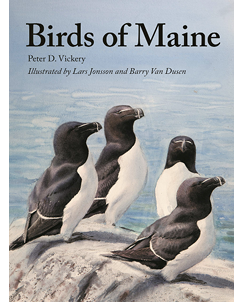Mark Lynch
 The Complete Birds of the World: Every Species Illustrated. Principle illustrators: Norman Arlott and Ber van Perlo. 2021. Princeton, New Jersey: Princeton University Press; Ireland: Harper Collins Publishers; Britain: William Collins.
The Complete Birds of the World: Every Species Illustrated. Principle illustrators: Norman Arlott and Ber van Perlo. 2021. Princeton, New Jersey: Princeton University Press; Ireland: Harper Collins Publishers; Britain: William Collins.
It has always been an ambition of mine to produce a colored checklist of every bird in the world, so I was more than happy when I was approached by Myles Archibald of Harper Collins to put together a book of the world’s birds, drawing on their collection of bird guide artwork. (p. 9)
This is exactly what Arlott says it is: a huge, illustrated checklist, 300 color plates illustrating more than 10,700 species, including most male and female plumages when those are different. No subspecies are illustrated. Species are mostly drawn to scale on each plate. Opposite the species plates is a page that includes the bird’s name and one short paragraph with details on length, spare details of plumage, voice, habitat, distribution, and where unique, behavior. Most of the illustrations are taken from the Collins field guides. There are no real extras. There is one full page of bird topography. There is a full-page world map, bizarrely without country names or borders, so it is a map of the continents.
Arlott is the author and illustrator of a number of books. His art has even appeared on stamps from countries such as Jamaica, the Bahamas, Liberia, and Fiji. Van Perlo has also illustrated many field guides. In addition, several of the illustrators have worked on South American field guides.
This is a very large and heavy book. Weighing 6.8 pounds, 11.25” x 9,” and almost two inches thick, this is not a book that is easy to read and enjoy. You are not going to nestle down in your easy chair and prop this book up on your knees without the danger of throwing some muscle out. Be careful not to drop it on your foot!
Because this book is mostly about the illustrations, let us focus on the plates. The individual bird illustrations are fine. But here is the one important caveat. On many pages there are too many birds shown, so that your eye cannot easily focus. Most of the species are illustrated facing to the reader’s left. Some, like the tropical ovenbirds (p. 273, plate 131), are more vertical. On many plates, birds overlap nearby species, so the visual chaos is even greater. On page 177, plate 83 is just one of the hummingbird plates. It is a good example of how too many birds crowded on a single page ultimately makes for a plate that is not enjoyable to look at. I certainly tried. I sat with the book on my lap, gazing at the plates for what seemed like hours. Your focus just cannot find a place to rest easily. Eventually, my eyes would glaze over, and sometimes I fell asleep. On close inspection, a few of the individual bird illustrations were not of the quality typical of the rest of that plate’s drawings and appeared to be hastily painted in. This includes the Black-crowned Antpitta and Rufous-crowned Antpitta on page 291, plate 140. Are these the work of a different artist?
So, how can you use this book? It is certainly not a field guide. You would need a wagon to carry this doorstop any distance. The written plumage details are minimal. If you are a hardcore world birder, you could use it as an unwieldly checklist, circling the names or illustrations of the species you have ticked. But there are much better online programs to keep track of your list. Lists that would not kill your cat should they fall on it. You could even dash around madly carrying the book screaming, “I have ALL the birds of the world!” Which could be fun but would likely wear thin in a short period of time. This behavior could get you locked up, which would cut into your birding time. In the end, I began looking at this as a challenge printing project. The challenge was: could you picture all the species of the world in just one volume. We now know that the answer is yes, it can be done, but now what do I do with it?
 National Audubon Society, Birds of North America. Various authors. 2021. New York, New York: Alfred A. Knopf.
National Audubon Society, Birds of North America. Various authors. 2021. New York, New York: Alfred A. Knopf.
Essays by leading scholars in each field provide holistic insights into the world of birds. (inside front flap)
I was looking forward to this guide, which was touted as “the complete guide to birding.” Sad to say that the book falls short of that promise.
This is another large book, but with a soft cover. It weighs four pounds and is 7.12” x 9.5” x 1.75”, making it impractical to bring into the field.
The introductory sections include typical sections on taxonomy, bird names, habitats, ranges, migration, courtship, breeding, and nesting. The vast and complex subject of avian intelligence (p. 10) is given just two paragraphs. Optics and photography are summed up in a mere two paragraphs (p. 13). There is a collection of brief essays on bird biology topics that include “Adaptions of Birds of Prey” (p. 16–18), “Confusing Fall Warblers” (p. 20–21), “Plunge-diving Behavior in Seabirds” (p. 19–20); and “Fly catching Habits, Adaptations, and Techniques” (p. 18–19). There are a variety of authors of these essays, one being natural historian Brian Cassie from Massachusetts. These essays are fine as far as they go, but they certainly are not the last word on the subject. Collectively, they seem unrelated, a hodgepodge of subjects thrown together in this book because they are about birds.
To make matters worse, these essays contain no references, and no list of references is found anywhere in this book. In one section titled “Corvid Intelligence” by John Marzluff, he writes, “Many people receive trinkets from their neighborhood crows.” (p. 27) “Many people?” I thought. My neighborhood crows have never left anything for me, ever. I searched for a reference to this seemingly anecdotal statement and could find no citation. Searching for a description of Marzluff’s research brought me to a single paragraph on page 907 that lists all the contributors with a single short line for each person, including “John Marzluff, Ph.D, author and the James Ridgeway Professor of Forest Resources at the University of Washington.” That tells the reader nothing as to why he would be appropriate as the author for this short essay on corvids. Researching Dr. Marzluff on the University of Washington website, I found:
“John Marzluff studies how humans affect birds through habitat fragmentation and increased urbanization, as well as the challenges of conserving birds on islands. He focuses primarily on corvids—that is, ravens, crows, and jays—but he has also worked with falcons and hawks throughout the world. Conversely, he is also interested in all the ways that birds affect people—how, for instance, birds influence art or language. In addition to his research, he has written several popular science books about crows, including, most recently, Gifts of the Crow: How Perception, Emotion, and Thought Allow Smart Birds to Behave Like Humans. In recognition of his work, he has been awarded the H.R. Painton Awards from the Cooper Ornithological Society, as well as the Washington State Book Award for general nonfiction.”
So, Dr. Marzluff is a good choice to write an essay on corvid intelligence, but why not include that information in the all too brief bios of the authors in this guide? Why are his books not included in a bibliography? These essays are interesting, but the reader should check out any one of several books focused on each topic. Of course, such a bibliography would have been nice to help readers who want to learn more. But there is none.
The species accounts take up the bulk of the book, pages 30–848. One page covers one species. Included for each species are a description of the bird and some plumage details, notes on its voice, nesting habits, range, subspecies, similar species, and conservation. A tiny black bird silhouette contains a two-letter code that refers to the International Union for Conservation of Nature’s (IUCN) list of threatened species. This runs from least concern to extinct (p. 15). Some of the written details on the conservation of a species seem contradictory. Under Buff-breasted Flycatcher we read:
Although its numbers are declining due to habitat loss, the small Arizona population may be increasing. Buff-breasted Flycatcher used to be more widespread in the southwestern United States, but its numbers reached a record low in the 1960s and only a small population remains north of Mexico—perhaps a few dozen pairs. It is recognized as a state-endangered species in Arizona. (p. 541)
The IUCN’s code for this species printed next to the above description is LC for least concern. Should we be concerned about the Buff-breasted Flycatcher or not? The IUCN does not consider it a bird of concern, yet the bird is declining, except, maybe it is not—in Arizona. Readers can be forgiven if they may find some of the conservation information in this guide somewhat confusing. Again, there are no references cited for any of the above statements.
The range maps included for each species are small and difficult to read because of poor color choices for the different types of occurrences. But the biggest surprise are the photographs. Small color photographs are shown for each species, typically four to five per page. Some of these are very small. The quality of these species portraits is generally good, but some are poor, such as the dark shot of the Cassin’s Auklet (p. 280). Important variations of plumages are not always depicted. For instance, many species of alcids are shown in breeding plumage only. Several photos were apparently chosen for aesthetic reasons, not to aid in identification, but are reproduced too small to be of real visual interest. My biggest caveat is that none of the photographs are labeled— not to species, not to plumage, nor age. The readers do not know if they are looking at a shot of a juvenile, female, or male. I picked up the guide to check on this again and again to see if I missed something. I did not.
The National Audubon Society Birds of North America ends with a glossary (p. 873–77), an index, and photography credits that run 20 pages (p. 886–906).
Although well-intentioned with many good points, this guide misses the mark. Certainly, some editing and layout decisions were not well thought out. The next edition, if there is to be one, needs to include a do-over of layout. This should include adding a bibliography and labeling the photographs. Photographs should show different plumages and be labeled; pretty is not enough. Perhaps, condense the photo credits to make room for some details on the authors’ bios instead. I could go on.
 National Geographic Complete Birds of North America. Third Edition. Edited by Jonathan Alderfer and Jon L. Dunn. 2021. Washington D.C.: National Geographic.
National Geographic Complete Birds of North America. Third Edition. Edited by Jonathan Alderfer and Jon L. Dunn. 2021. Washington D.C.: National Geographic.
This book includes all species of native birds reliably recorded in North America, which we describe as the continent north of Mexico, plus adjacent islands and seas within 200 miles of the coast. (p. 6)
Good ole NatGeo! This book has clearly defined goals and accomplishes them—details and illustrations of all species that have been seen in North America.
The species accounts make up the bulk of the book, pages 10–735. Each species has details on identification: winter as well as adult male and female plumages. There are notes on similar species, voice, status, and distribution: breeding, winter, migration, and where it is rare. The maps are larger than in the National Audubon book described above and are easy to read. The illustrations are detailed and helpful, with important field marks labeled on the illustration. There are introductory paragraphs to the bird families illustrated with color photographs. These can be a few paragraphs or a full page or more and are interesting to read. There are also sidebars, usually several paragraphs, on topics such as waterthrush identification (p. 681), Calidris plumage and structural details (p. 169), flight identification of Long-eared and Short-eared owls (p. 389), and the Singer Tract and James T. Tanner (p. 413). Each of these is in the section of the book next to the birds described. The species accounts end with a page on the birds of Greenland (p. 734) and Bermuda (p. 735). These two sections include a list of species found there, not on mainland North America. There are three pages of biographies of the contributors. Each contributor is given a good-sized paragraph. Drawing and photography credits take up two densely printed pages. Everything in this guide is clear, concise, and easy to read. The pages are well laid out.
The introductory sections are brief and include topics such as taxonomy, plumage variation, feather topography, and abundance terms and codes. They use the Bird Life International and IUCN codes.
I found myself reading entries on species that are true rarities for North America, such as Great Spotted Woodpecker (p. 406), Slender-billed Curlew (p. 160), and Mottled Owl (p. 385). Though this is a large book weighing 4.6 pounds and measuring 7” x 10” x 2,” it is easy to read and enjoy. You cannot really take this hefty guide into the field, but you could use it at home to clarify the identification of species you have photographed. The National Geographic Complete Birds of North America continues to be a good home reference as well as a fun book to dip into.
 Birds of Maine. Peter D. Vickery. Barbara S. Vickery and Scott Weidensaul (Managing Editors). Charles D. Duncan, William J. Sheehan, and Jeffrey V. Wells (co-authors). 2020. Princeton, New Jersey: Princeton University Press.
Birds of Maine. Peter D. Vickery. Barbara S. Vickery and Scott Weidensaul (Managing Editors). Charles D. Duncan, William J. Sheehan, and Jeffrey V. Wells (co-authors). 2020. Princeton, New Jersey: Princeton University Press.
It is bittersweet, however, because Peter did not live to see it through to completion. After receiving what was ultimately a terminal cancer diagnosis in 2015, he had the foresight to assemble a team of friends and colleagues, representing some of the best ornithologists in Maine, initially to help him and eventually, to assume the task of completing his magnum opus, and to recruit Lars Jonsson and Barry Van Dusen to provide their extraordinary art. (p. xiii, Foreword by Barbara S. Vickery)
Peter D. Vickery died in February 2017, and his magnum opus, Birds of Maine, is a stunner. This is a magnificent volume, beautifully laid out, and the definitive volume about birds in Maine as of the early twenty-first century.
This is not an identification guide, but an annotated history of birds in Maine. Most species accounts include a description of its status in Maine. For example, under Ivory Gull: “Ivory Gulls are casual along the Maine coast in winter and spring. There are 16 winter and three spring sightings since 1894.” (p. 256). A nice touch is that each species has an introductory descriptive sentence. Under Ivory Gull: “A strikingly white, almost pigeon-like gull from the icy Arctic.” (p. 256) This is followed by the species’ historical status in Maine, its global distribution, a description of its conservation status, and then exact dates and locations of sightings of the bird.
But it is the extra content that sets this volume apart from other state bird accounts. This includes a large section on “The Distribution of Birds in Maine” (p. 7–29, which includes sections on the Gulf of Maine surface temperatures, the blueberry barrens, the ecoregions of Maine, and much more).
Next is a section about “Maine’s Ornithological History” (p. 31–41) and “The Current Status and Conservation Needs of Maine Birds” (p. 42–67). There are pages of charts detailing “Breeding Bird Survey Annual Trend Estimates” (p. 68–69) and Christmas Bird Count trend estimates (p. 70–71). These introductory sections feature color photography, full color paintings— including a full-page painting of a Great Auk (p. 42)—and several drawings. Even the surveys are in color. There are a number of color maps of Maine, including four full pages of a color roadmap of the state complete with conservation areas and parks.
Birds of Maine contains several appendices (p. 583–600), including “Geographic place names found in Birds of Maine text” (p. 584–91). It ends with a long section of “Works Cited” (p. 601–27) and an index. Whew!
Birds of Maine is an embarrassment of riches, a sumptuous volume that is both a definitive account of the birds of Maine at the time of its publishing, and a perfect tribute to Peter D. Vickery, who so deeply loved the birds of his state. There are many touches that make this volume an outstanding addition to any birder’s library. There are full page color photographs, including a two-full-page aerial shot of a boardwalk snaking through Saco Heath (p. 26–27). There are full-page color paintings that include a two-page painting of a Snowy Owl (p. 350–51); an Olive-sided Flycatcher (p. 388–89), and Common Ravens (p. 414–15). Even the species maps are in color. Special mention has to be made of Barry Van Dusen’s black-and-white drawings that are found throughout the book and really liven up the text.
But there is a real problem with Birds of Maine. It is tough to read without something to prop it up because of its weight and size: 7.2 pounds and 12”x 9” x 1.75.” I threw my shoulder out casually handling this book. It is interesting to compare it to Birds of Massachusetts by Veit and Petersen (1993). That book lacks all the colorful bells and whistles of Birds of Maine. There are no color photographs or paintings, though there are full-page black-and-white drawings by Barry Van Dusen. Maps are simple and black and white. The concise introductory sections cover the same ground, more or less, as those sections in Birds of Maine. If you are interested in historical bird records, Birds of Massachusetts gets the job done in much less space. At 2.4 pounds and 9.25” x 6.25” x 1.5,” Birds of Massachusetts is the size of a typical book and therefore is easy to read.
Eventually, the fate of these huge state ornithological histories will be to exist online. In this format, they can be easily updated and corrected and save paper. These online references will have all the bells and whistles of Birds of Maine—you just will not own them. The best example is Birds of the World online, hosted by Cornell University. It is supported by yearly subscriptions. All the details of a species’ life are included, plus recordings of songs and calls, and lots of color photographs. The range maps are large and in color. I use that resource often because of the convenience, ease of use, and scholarly content. Birds of Maine is an amazing book, detailed, definitive, and beautiful. It is a perfect tribute to Peter D. Vickery; congratulations to all the authors and artists who saw this personal work to completion. But, like the Great Auk pictured in Birds of Maine, it is likely that this kind of volume is doomed to extinction.
Reference
- Veit, Richard R. and Wayne R. Petersen. 1993. Birds of Massachusetts. Lincoln, Massachusetts: Massachusetts Audubon Society.
To listen to Mark Lynch’s conversation with Jonathan Alderfer about the National Geographic guide, go to https://www.wicn.org/podcast/jonathan-alderfer/.